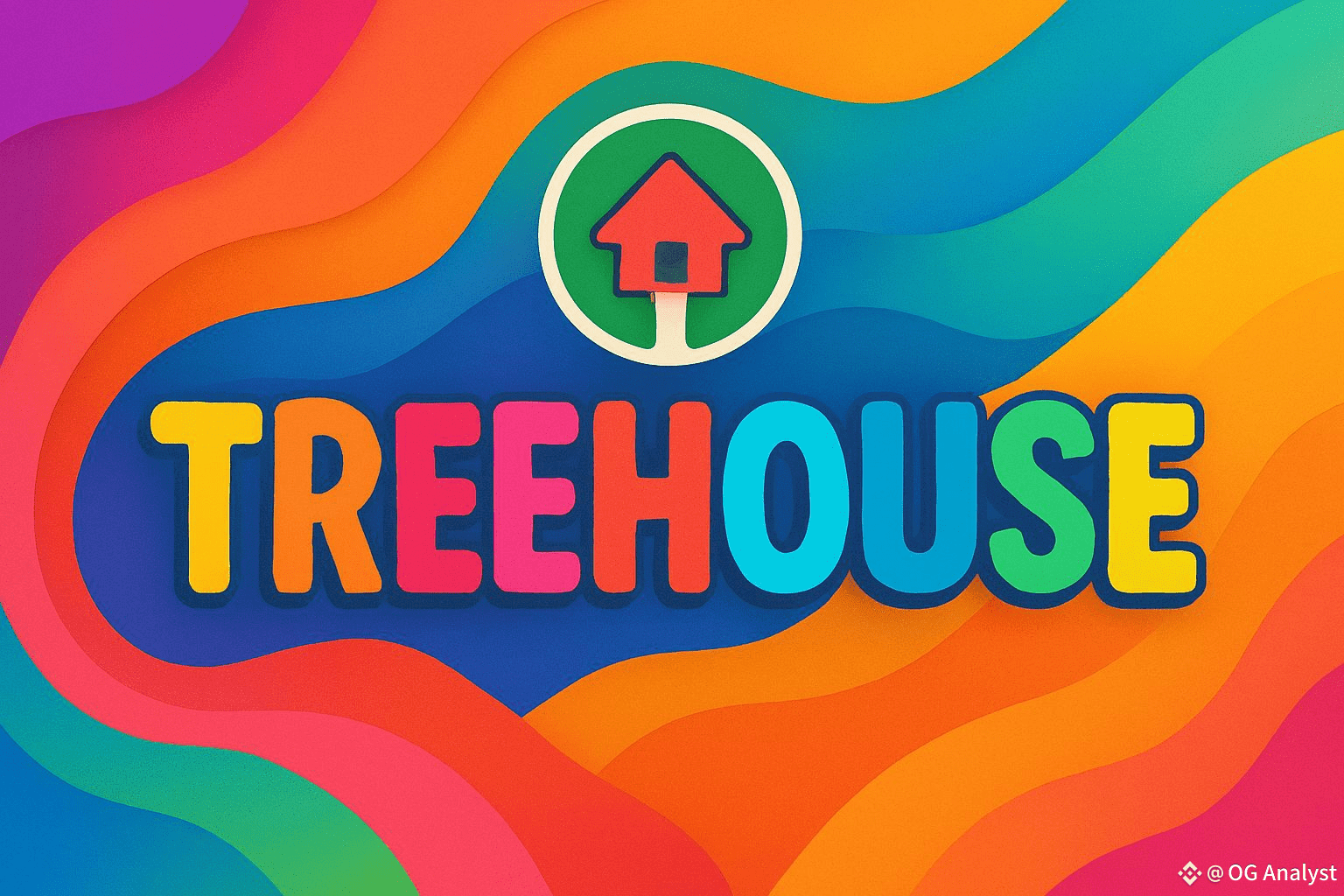Imagine a world where decentralized finance (DeFi) offers the stability of traditional fixed-income investments, blending the reliability of bonds with the innovation of blockchain. Enter Treehouse (TREE), a trailblazing DeFi protocol that’s carving a niche as the decentralized fixed-income layer, and its recent integration into Binance’s ecosystem has set the crypto community abuzz. Launched on July 29, 2025, via Binance’s HODLer Airdrop and Alpha programs, TREE is not just another token—it’s a bold step toward redefining how predictable yields and structured financial products can thrive on-chain.

What is Treehouse (TREE)?
Treehouse, developed under the umbrella of Treehouse Labs, is a decentralized protocol designed to bring the predictability and structure of fixed-income instruments to the volatile world of DeFi. Unlike speculative tokens chasing hype, TREE anchors itself in delivering stable, transparent yields through innovative mechanisms like Decentralized Offered Rates (DOR) and tokenized assets (tAssets). Think of it as a bridge between the disciplined world of traditional finance and the boundless potential of Web3. With a total supply of 1 billion tokens and an initial circulating supply of 186.12 million (18.6%), TREE operates on both Ethereum and BNB Chain, ensuring accessibility and interoperability.
The protocol’s mission is to create a robust infrastructure for fixed-income products, enabling users—whether individual investors, DAOs, or institutions—to earn consistent returns without the rollercoaster of crypto volatility. Its listing on Binance, alongside other top-tier exchanges like Coinbase, OKX, Bybit, and KuCoin, underscores its credibility and ambition to scale. But what truly makes TREE stand out is its focus on solving real-world DeFi pain points, from unpredictable staking returns to fragmented yield data.

Binance’s Embrace: A Game-Changing Launch
On July 28, 2025, Binance announced Treehouse as the 29th project in its HODLer Airdrop program, rewarding BNB holders who subscribed to Simple Earn or On-Chain Yields between July 10–13, 2025, with 12.5 million TREE tokens (1.25% of total supply). This retroactive airdrop, requiring no additional user action, reflects Binance’s strategy to incentivize long-term holding and democratize access to high-potential projects. Additionally, TREE was featured on Binance Alpha, a launchpad for vetted early-stage crypto ventures, highlighting its innovative solutions and strong community backing.
Starting July 29, 2025, at 14:00 (UTC), TREE became available for trading on Binance Spot with pairs including TREE/USDT, TREE/USDC, TREE/BNB, TREE/FDUSD, and TREE/TRY. It was also integrated into Binance’s broader ecosystem, including Simple Earn (offering TREE Flexible Products with subscription starting July 29), Binance Convert (zero-fee trading against BTC and USDT), Binance Margin (as a borrowable asset), and Binance Futures (with a USDⓈ-M TREE Perpetual Contract offering up to 75x leverage). This multi-platform integration amplifies TREE’s liquidity and accessibility, positioning it as a versatile asset for traders and yield-seekers alike.
However, TREE’s debut wasn’t without turbulence. Despite the buzz around its Binance airdrop, the token plummeted over 50% within 24 hours of launch, dropping to 0.53 amid high trading volume (350–374.93 million). This bearish divergence, driven by intense selling pressure, suggests early profit-taking or market skepticism. Yet, technical indicators like the Relative Strength Index (RSI) rebounding from oversold levels hint at potential recovery, with analysts eyeing a short-term rally to 0.76 or even 1 if buying momentum builds.

Unique Features: The Heart of Treehouse’s Innovation
Treehouse’s allure lies in its groundbreaking approach to DeFi, blending traditional finance’s stability with blockchain’s flexibility. Here are its core features, each a pillar of its vision to redefine fixed-income markets:
Decentralized Offered Rates (DOR): DOR is Treehouse’s answer to the chaotic yield landscape in DeFi. Modeled after traditional benchmarks like LIBOR or SOFR, DOR is a consensus framework that standardizes on-chain interest rates. Its flagship benchmark, the Treehouse Ethereum Staking Rate (TESR), aggregates daily forecasts from expert panelists (e.g., Staking Rewards, RockX, LinkPool) to provide a reliable reference for Ethereum staking yields. This transparency enables structured products, lending markets, and interest rate derivatives, fostering a more predictable DeFi ecosystem.
tAssets for Yield Generation: Treehouse’s tAssets, like tETH, are liquid staking primitives designed for capital efficiency. These tokenized assets allow users to stake while retaining flexibility to participate in DeFi protocols, supporting over 52,400 active users. tAssets integrate staking and rate arbitrage strategies, offering predictable yields and composability across DeFi platforms. This makes them ideal for investors seeking steady income without locking funds in rigid structures.
Pre-Deposit Vaults: Post-launch, Treehouse introduced Pre-Deposit Vaults, time-limited staking pools tied to DOR panelists, offering a guaranteed 50–75% APR for 30 days. These vaults incentivize early adoption and support the protocol’s rate-forecasting ecosystem, rewarding users for contributing to its decentralized governance.
Governance and Utility: TREE isn’t just a speculative asset; it’s a governance and utility token. Holders can stake TREE to support DOR panelists, vote on protocol upgrades, earn rewards based on forecast accuracy, and pay on-chain fees for benchmark data access. This multi-faceted utility embeds TREE deeply within the Treehouse ecosystem, driving long-term value.
Robust Infrastructure: With over 550 million in Total Value Locked (TVL) and 10+ security audits, Treehouse emphasizes trust and scalability. Its interoperability with other DeFi tools allows users to build diversified income portfolios, making it a cornerstone for long-term holders and DAO treasuries.
What Sets TREE Apart?
In a sea of DeFi projects, TREE stands out for its focus on fixed-income infrastructure, a niche that remains underexplored. Unlike yield-farming protocols chasing high APYs with high risks, Treehouse prioritizes stability and transparency. Its DOR framework addresses a critical gap in DeFi: the lack of standardized, reliable yield benchmarks. By enabling structured products like Forward Rate Agreements (FRAs), Treehouse paves the way for institutional-grade financial strategies on-chain, appealing to both retail and institutional investors.
Moreover, Treehouse’s 400 million valuation, backed by heavyweights like yZi Labs and Wintermute, signals strong market confidence. Its community-driven approach, with 10% of tokens distributed via the GoNuts Season 1 rewards program, fosters engagement and loyalty. The protocol’s roadmap—expanding tAssets to new base chains and Layer-2 networks—promises scalability and broader adoption, positioning TREE as a long-term player in DeFi’s evolution.
Challenges and Risks
Despite its promise, TREE’s rocky launch highlights the volatility of early-stage tokens. The 50% price crash post-listing, despite Binance’s airdrop hype, underscores the risks of speculative selling and market uncertainty. With only 18.6% of the total supply in circulation, future token unlocks could further pressure prices if not managed carefully. Technical indicators suggest a potential drop to 0.30 if bearish trends persist, though a rebound to 0.76–1 remains possible with renewed buying interest.
Additionally, regulatory risks loom large. Binance’s airdrop excludes users from jurisdictions like the US, UK, and Canada due to compliance issues, limiting global accessibility. Investors are urged to conduct thorough due diligence, as early-stage projects like TREE carry inherent risks of volatility and project failure.
The Road Ahead
Treehouse’s vision extends beyond its initial launch. The protocol is gearing up to introduce derivative primitives like FRAs, expand tAssets to new chains, and enhance its DOR framework to support a wider range of fixed-income products. Its integration with Binance’s ecosystem, coupled with listings on top exchanges, provides a springboard for global reach. Posts on X reflect growing excitement, with influencers touting TREE as a “DeFi intelligence engine” akin to a “Bloomberg Terminal for Web3,” hinting at its potential to become a go-to platform for yield-focused investors.
Conclusion
Treehouse (TREE) is more than a token; it’s a blueprint for a new era of DeFi where stability meets innovation. By blending fixed-income principles with blockchain’s flexibility, it offers a compelling alternative to speculative crypto ventures. Its Binance-backed launch, robust features like DOR and tAssets, and ambitious roadmap make it a project to watch. Yet, its volatile debut serves as a reminder of the risks inherent in early-stage tokens. For those seeking predictable yields in DeFi’s wild jungle, TREE could be the map to navigate it—just tread carefully and do your own
$TREE @Treehouse Official #Treehouse